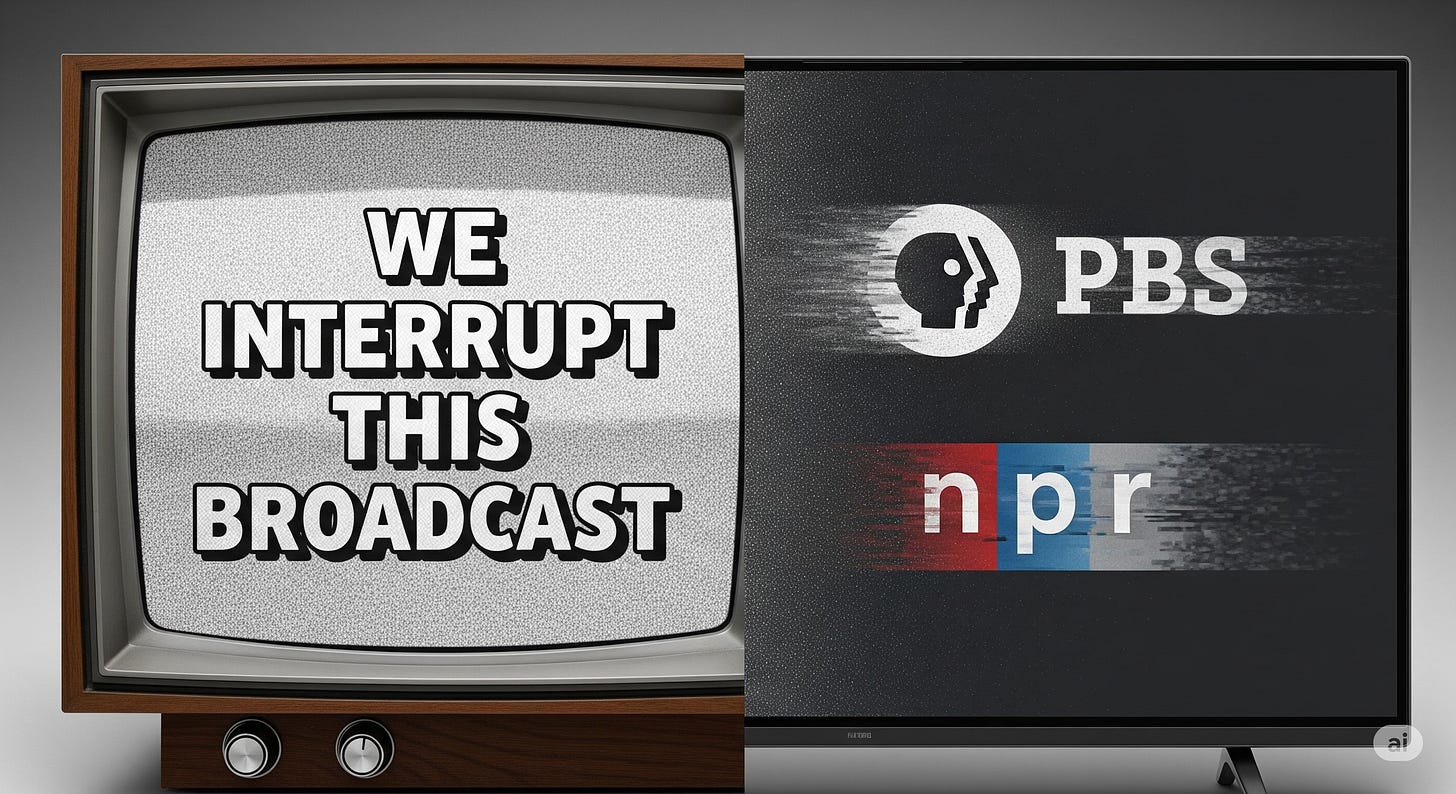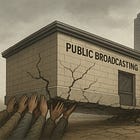Why “Asking for More” isn’t Enough
A half-century of warnings, and public media still wasn’t ready.

Correction: An initial version of this piece incorrectly stated the year the Nixon White House threatened to cut CPB funding; it was 1969.
Public media in America is in a recession, whether we call it that or not.
Layoffs are spreading. Programming is being cut. Confidence in the future is faltering. And after the federal government ended funding for the Corporation for Public Broadcasting, the safety net that sustained stations for more than half a century is gone.
All over the country, public TV and radio stations are on air asking for more. More pledges. More dollars. More belief that everything will be OK. But the truth is: everything has changed.
Lowe: Naming the Crisis
“By any reasonable measure, public media in the United States is in a recession.
We may not call it that in formal memos or meetings.
But the indicators are all present.Core funding has abruptly declined.
Layoffs are spreading.
Community services are being cut or scaled back.
Confidence in future stability is faltering.These are not isolated issues.
Taken together, they signal a widespread contraction across the system.In economic terms, a recession is defined by a sustained decline in output, investment, and employment.
Public media is experiencing all three.”—David Lowe, President of PBS KVIE
Lowe is right. And while local station leaders may want to project confidence, and may even believe things will be fine, the reality is, for them, everything has changed.
Ramsammy: A Call to Build
Writing in Current last month, Andrew Ramsammy, president of Vermont College of Fine Arts, put it this way:
“Leadership in this moment doesn’t wait.
It builds.Build your own raft.
Out of wood, scrap, memory, and mission.
Stitch it together with the stories of your community.
Patch it with truth, creativity, failure, and vision.And when it’s ready, push off.
Let others see you do it —
not because you’re trying to be a hero,
but because you’re refusing to disappear.”
Doing more of the same isn’t building.
Bass: Owning the Problem
Steve Bass, former president and CEO of Oregon Public Broadcasting, offered this advice:
“Don’t outsource your strategy and future to NPR or PBS.
They have their own strategies —
and their own futures to deal with.Those may not be aligned with your organization’s interests.
No one else is going to care as much about your organization
as you and your governing board.Like it or not,
this is your problem to solve.”
So why isn’t doing more of the same the right thing? After all, membership drives have long been public media’s fundraising foundation.
Beyond “More of the Same”
It’s safe to assume that the public, your listeners and viewers, don’t understand the stakes. They don’t know what CPB did, or why some content also shows up on Amazon or Acorn. And while Lowe, Ramsammy, Bass, and others argue that stations need to “communicate the stakes clearly,” I’d say their response has been anything but.
There were other options. Stations could have gone dark for a limited time, replacing programming with a blunt message: This is what you will lose if we can’t continue.
Too scary? Then run a crawl across the bottom of shows that might vanish. Make it tangible.
And this isn’t a new idea.
In the early 1970s, some public stations actually did go dark when state or federal funding was threatened. One of the best‑known examples came in April 1971, when New Jersey Network signed off amid deep cuts.
Later, NPR member stations experimented with their own “dark moments.” In 1988, for example, Kentucky’s WKMS‑FM turned a lightning‑strike outage into a campaign called Sounds of Silence, a pointed reminder of what the community would lose without public radio. That year’s pledge drive exceeded its goal.
The strategy tapped into loss aversion, the truth that people don’t fully value what they have until they see it slipping away. A dark screen or a silent broadcast delivered a punch no pledge‑drive script ever could.
It may, indeed, be too late for that play now.
A Crisis Years in the Making
Why differently, and why now? Because this crisis didn’t come out of nowhere. It’s been looming for decades.
Even back in 1967, when Congress debated the Public Broadcasting Act, there were Republicans and Democrats who opposed creating the Corporation for Public Broadcasting. Amendments tried to strip out its funding mechanism. They failed — but the warnings were there.
The first serious push to defund public broadcasting came under President Richard Nixon. In 1969, the Nixon White House tried to rein in what it saw as “anti‑administration” content by threatening to cut CPB funding, using appropriations as leverage for a system‑wide reorganization. It was the earliest recorded executive attempt to defund public media.
With that kind of foreshadowing, it’s fair to ask: why didn’t stations plan better? Why didn’t they treat federal dollars as a bonus, instead of money needed to keep the lights on?
Do Something Different
Crisis fundraising can work — but only about 8% of those donors stick around. To move that number, to build real resilience, stations need more than a lifeline.
Here’s what “different” looks like:
1. Radical Transparency
Stop telling your audience “we need your support” without saying why. Share the real numbers. What’s the gap? What programs are at risk? What happens if the dollars don’t come in?
And let’s be honest: at many stations, even the staff don’t fully understand the finances. If your own team can’t explain where the money goes, how can you expect your listeners, viewers, and readers to understand?
Yes, the finances can be complex, especially for stations running both TV and radio. That’s why leaders need to find a simpler way to explain it. If you can’t make your case in plain language, you’ll never make it stick.
2. Make It Tangible
Don’t just ask for support. Show the loss. Whether it’s a crawl at the bottom of a show, a dark screen for an hour, or a digital campaign showing what disappears without funding, make it real. People don’t fully value what they have until they see it slipping away.
3. Build for Resilience
Treat emergency dollars as seed money for a new model, not as a patch for the old one. That means experimenting with partnerships beyond the usual suspects — libraries, schools, local nonprofits — and making membership more than a pledge drive once or twice a year.
And here’s the test: if your staff and your audience can’t explain your plan in one sentence, it’s not a real plan. Resilience isn’t built on jargon or 30‑page strategies. It’s built on clarity that everyone, inside and outside the station, can own and repeat.
Because “more of the same” won’t work.
And it never has.
PS - If you found this post helpful, would you please consider restacking it and sharing it with your audience?
This spreads the word and keeps me writing the types of content that you have enjoyed.






"Stop telling your audience “we need your support” without saying why. Share the real numbers"
Hear hear! I think the anecdotal evidence from the past two and a half weeks makes this crystal clear, yet some are still shying away from it